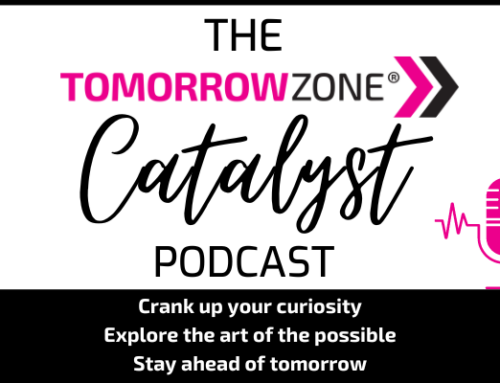
In a livestream for Monitor, “Embracing AI as a Catalyst for Unlocking Your Potential,” I had the pleasure of discussing a crucial topic in today’s business landscape: Overcoming Fears of AI in Your Organization. My guests were Camtu Vo, Manager of Product Development for DLL and Tina Cartwright, SVP, Transformation Strategic Executive at US Bank. Our conversation highlighted the importance of addressing the human condition when it comes to adoption of new technologies and emphasized the need for curiosity, collaboration, and responsible usage. In this blog post series, I’ll share key takeaways that business and technology leaders can consider applying in their own organizations to help their teams embrace AI and foster innovation.
When consider the pace of change, especially with Generative AI advances, we can now create anything we imagine almost instantly. I find this incredibly exciting. For a lot of people this can be scary. An innovation study by McKinsey1 investigated what holds back innovation. They found that 85% of the executives they interviewed said, fear often, or always holds back innovation efforts. Not only that, 90% are doing nothing to allay these fears.

Understanding the Root Cause: Fear
The root cause of resistance to AI adoption often boils down to fear. Fear of change, fear of the unknown, fear of job displacement – these are common concerns that can hinder progress. Effectively addressing these fears, requires first understanding their origins and recognizing that humans are creatures of habit who tend to stay within their comfort zones.
The Party Crasher Analogy
Making the concept of AI more relatable, Camtu Vo offered a brilliant analogy: AI as a party crasher. Just like a surprise guest at a party, AI has arrived on the scene, and there are three possible reactions: flight, fight, or adapt.
- Flight Instinct: Trying to avoid AI is not a viable option because it’s already here, and it’s not going away.
- Fight Instinct: Resisting AI can lead to tension and hinder progress.
- Adaptation: The most effective approach is to embrace AI, get to know it, and understand its potential. Just as we would engage with a party crasher by asking questions and making introductions, we should do the same with AI.
Overcoming Fear Through Learning and Connection
The key to overcoming fear is knowledge. To successfully integrate AI into your organization, follow these steps:
- Learn About AI: Start by educating yourself and your team about AI. Understand its capabilities, limitations, and potential applications within your industry.
- Make Connections: Identify how AI can fit into your existing roles and processes. Recognize where AI can enhance human capabilities rather than replace them.
- Start Small: Begin with manageable AI projects or pilot programs. This allows your team to gain hands-on experience and build confidence gradually.
- Collaborate: Encourage collaboration between humans and AI. Emphasize that AI is a tool to augment or enhance human capabilities.
- Responsible Usage: Set guidelines for responsible AI usage, especially regarding data privacy and security. Generative AI (like Chat GPT, Bing, or others that automatically generate content via a plain English chat interface) is easy to access and easy to use but remember, while AI can provide a valuable first draft, it should never be the final product.
The Human-AI Partnership
Tina Cartwright highlighted the importance of bridging the gap between humans and AI. While AI can process vast amounts of data and provide insights, it lacks human judgment and context. The real magic happens when humans and AI collaborate to achieve common goals.
Furthermore, Tina pointed out that AI is not entirely new. It has been around for decades, but recent advancements have brought it into the spotlight. Understanding this context is crucial to overcoming the fear of AI as it shows that AI is not a mysterious newcomer but a tool with a history of enhancing various industries.
Embracing AI at TomorrowZone
I shared a glimpse of how we approached Generative AI adoption at TomorrowZone. It began with personal experimentation and learning about using the technology to enhance professional productivity. Once comfortable, I introduced my team to ChatGPT, showing them how to use it and encouraging them to explore its potential.
Crucially, we emphasized that Generative AI is a tool to accelerate work, not a replacement for human judgment and creativity. We also set guidelines for responsible AI usage, emphasizing data privacy and security.
Conclusion
In the rapidly evolving business landscape, embracing AI is essential for staying competitive and driving innovation. However, fear and uncertainty can hinder progress. By understanding the root causes of fear, making connections, starting small, collaborating, and using AI responsibly, organizations can overcome these obstacles and harness the power of AI to achieve their goals.
Remember, AI is not a party crasher to be feared; it’s a valuable guest at the innovation party, ready to collaborate and enhance human potential. Embrace AI, and together, we can create a brighter future for our organizations and industries.
At TomorrowZone, we understand that digital ROI is not just about technology; it’s about people. The statistics speak volumes: 85% of leaders acknowledge that fear stifles innovation, and 90% struggle with mitigating these fears.
Don’t let uncertainty hold you back. Whether you’re at the forefront of innovation or taking the first steps towards digital transformation, our team is here to guide you. From strategic roadmaps to streamlining processes with technology, we help you navigate the human side of innovation, ensuring your team not only adopts technology but thrives with it.
Contact TomorrowZone today, and together, we’ll transform the ‘party crasher’ into your most valued guest. Let’s unleash the full potential of technology and chart a course for success in your organization. Embrace the future—fearlessly.
1 McKinsey world-wide survey and indepth interviews of executives leading and executing innovation projects in large organizations - article, “Fear Factor: Overcoming Human Barriers to Innovation,” Laura Furstenthal, Alex Morris, and Erik Roth June 3, 2022





